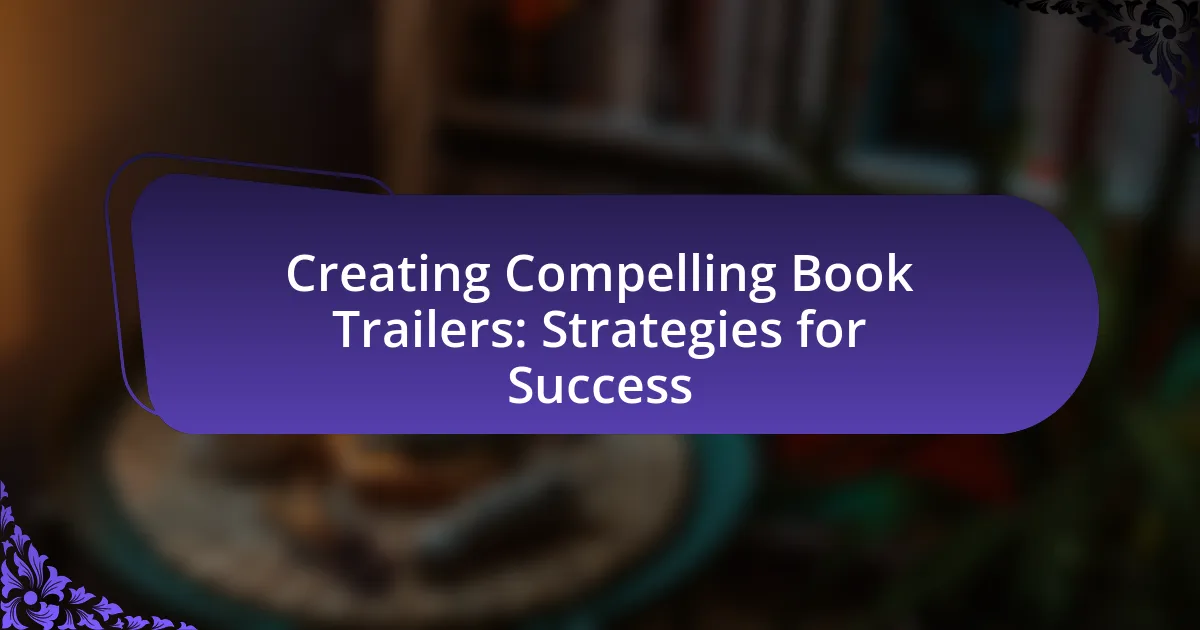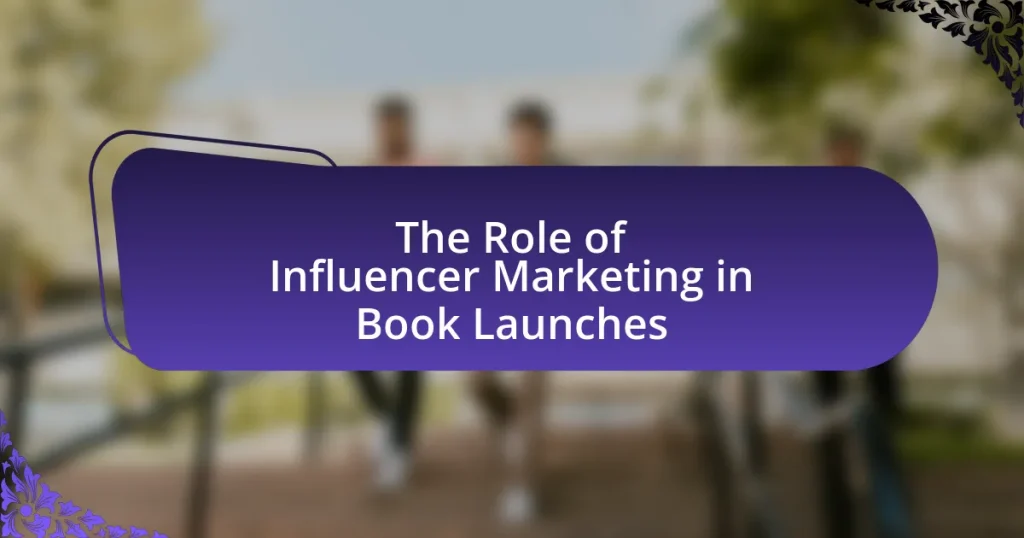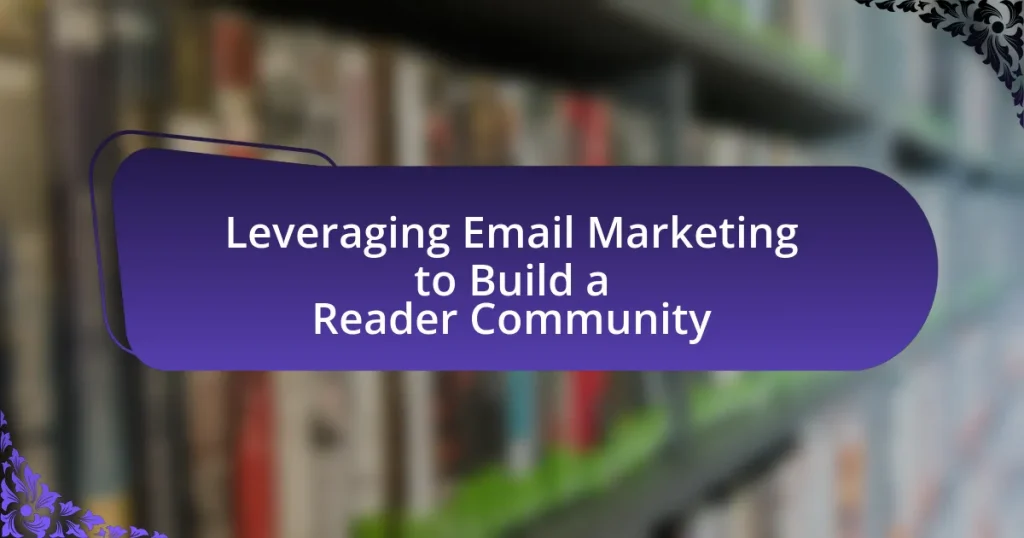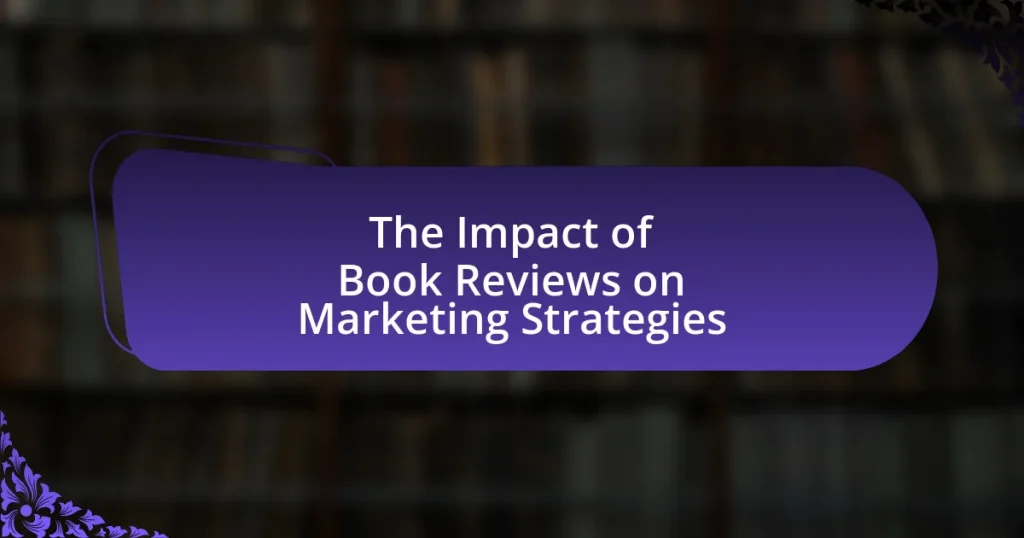The article focuses on the creation of compelling book trailers, emphasizing their significance in modern book marketing. It outlines the differences between book trailers and traditional marketing methods, highlighting the effectiveness of visual storytelling in engaging potential readers. Key components of successful book trailers, such as narrative, visuals, and audio elements, are discussed, along with strategies for defining target audiences and promoting trailers effectively. Additionally, the article addresses common pitfalls to avoid and best practices for ensuring that trailers align with the book’s themes, ultimately aiming to enhance visibility and drive sales.
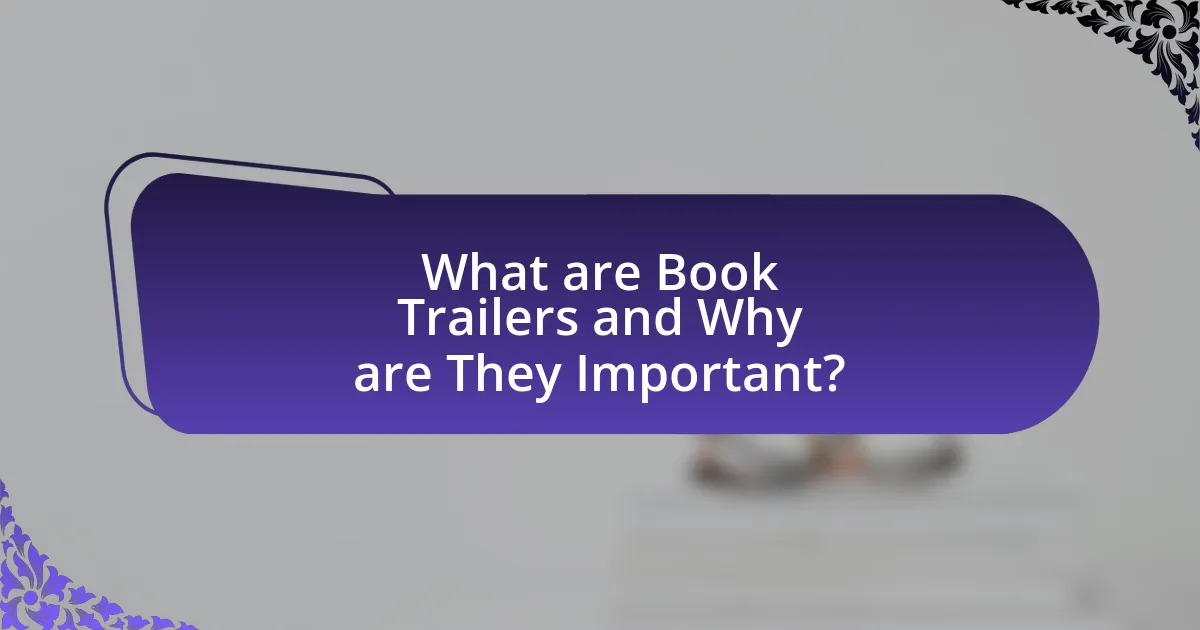
What are Book Trailers and Why are They Important?
Book trailers are short video presentations that promote a book, similar to movie trailers, designed to engage potential readers and generate interest. They are important because they leverage visual storytelling to convey the book’s themes, tone, and key elements, making it easier for audiences to connect emotionally with the content. Research indicates that visual content can increase engagement rates significantly; for instance, videos are known to generate 1200% more shares on social media than text and images combined. This heightened engagement can lead to increased book sales and a broader reach for authors and publishers.
How do Book Trailers differ from Traditional Book Marketing?
Book trailers differ from traditional book marketing primarily in their format and engagement strategy. While traditional book marketing often relies on print advertisements, author signings, and book reviews, book trailers utilize video content to visually and emotionally engage potential readers. This multimedia approach can capture attention more effectively, as studies show that video content is processed 60,000 times faster than text by the human brain, making it a powerful tool for conveying a book’s themes and tone. Additionally, book trailers can be easily shared across social media platforms, enhancing reach and visibility compared to static marketing materials.
What elements make a Book Trailer effective?
An effective book trailer includes engaging visuals, a compelling narrative, and a strong call to action. Engaging visuals capture the audience’s attention and convey the book’s tone, while a compelling narrative succinctly summarizes the plot or themes, enticing viewers to learn more. A strong call to action encourages viewers to purchase or read the book, making it clear what the next step should be. Research indicates that trailers with these elements can increase viewer interest and sales, as they create an emotional connection and provide a clear message about the book’s value.
Why should authors consider creating a Book Trailer?
Authors should consider creating a Book Trailer because it serves as an effective marketing tool that can engage potential readers visually and emotionally. A well-crafted Book Trailer can increase visibility and interest in a book, as studies show that video content is more likely to be shared on social media, leading to a broader reach. For instance, according to a report by HubSpot, video content can increase engagement rates by up to 1200%, making it a powerful medium for authors to showcase their work and connect with their audience.
What types of Book Trailers exist?
There are several types of book trailers, including animated trailers, live-action trailers, and slideshow trailers. Animated trailers utilize graphics and animations to convey the book’s themes and story, while live-action trailers feature actors and real-life settings to create a cinematic experience. Slideshow trailers combine images, text, and music to summarize the book’s content in a visually engaging format. Each type serves to attract potential readers by showcasing the book’s essence and generating interest.
How do Animated Book Trailers compare to Live-Action Trailers?
Animated book trailers utilize animation techniques to visually represent a book’s themes and characters, while live-action trailers employ real actors and settings to convey the story. Animated trailers often allow for greater creative freedom, enabling the depiction of fantastical elements that may be difficult or costly to achieve in live-action. For instance, animated trailers can easily incorporate surreal visuals or abstract concepts, which can enhance the storytelling experience. Conversely, live-action trailers can create a more immediate emotional connection with the audience through relatable human expressions and real-world settings. Research indicates that animated content can increase viewer engagement by up to 80%, while live-action trailers may resonate more with audiences seeking authenticity. Thus, the choice between animated and live-action trailers depends on the book’s genre, target audience, and the specific message the author wishes to convey.
What role does music play in a Book Trailer?
Music plays a crucial role in a book trailer by enhancing emotional engagement and setting the tone for the narrative. The right music can evoke specific feelings that align with the book’s themes, drawing viewers into the story and creating a memorable experience. Research indicates that music significantly influences audience perception; for instance, a study published in the Journal of Consumer Research found that background music can alter emotional responses and increase viewer retention of the content. Therefore, incorporating well-chosen music in a book trailer not only complements the visuals but also reinforces the overall message and appeal of the book.
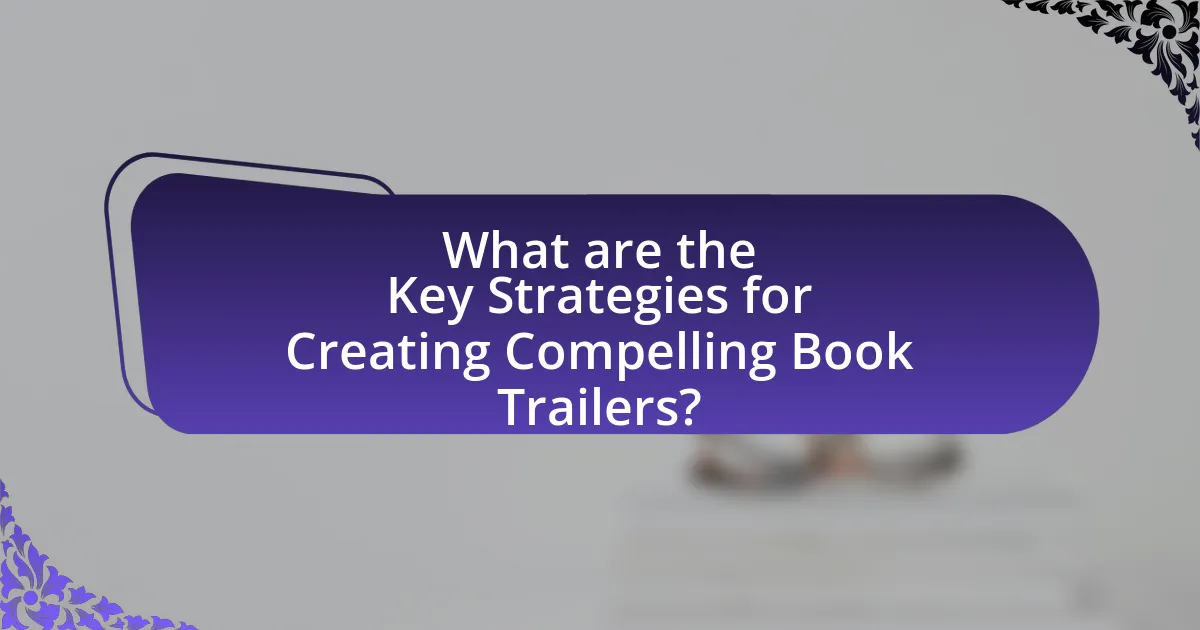
What are the Key Strategies for Creating Compelling Book Trailers?
Key strategies for creating compelling book trailers include focusing on a strong narrative, utilizing high-quality visuals, and incorporating engaging audio elements. A strong narrative captures the essence of the book, enticing viewers by highlighting key themes or conflicts. High-quality visuals, such as professional graphics or footage, enhance the trailer’s appeal and maintain viewer interest. Engaging audio elements, including background music and voiceovers, create an emotional connection and set the tone for the story. Research indicates that trailers with these elements can significantly increase viewer engagement and interest in the book, leading to higher sales and visibility.
How can authors define their target audience for a Book Trailer?
Authors can define their target audience for a book trailer by analyzing demographic data, reader interests, and genre-specific trends. This involves researching the age, gender, and preferences of potential readers, which can be gathered from platforms like Goodreads and social media analytics. For instance, a study by the Pew Research Center indicates that 72% of teens read books, suggesting that a young adult novel’s trailer should appeal to this demographic through relatable themes and visuals. Additionally, authors can engage with online communities and forums to gather insights on what resonates with their audience, ensuring that the trailer effectively captures the attention of the intended viewers.
What questions should authors ask to understand their audience’s preferences?
Authors should ask questions such as: “What genres do my readers prefer?” and “What themes resonate most with my audience?” Understanding these preferences helps tailor content effectively. Research indicates that 70% of readers are more likely to engage with books that align with their interests, highlighting the importance of audience insight. Additionally, inquiries about preferred formats, such as e-books versus print, and the types of characters or settings that captivate them can further refine an author’s approach. This targeted questioning enables authors to create compelling book trailers that resonate with their audience’s tastes.
How does audience understanding influence the trailer’s content?
Audience understanding significantly influences a trailer’s content by shaping the themes, tone, and messaging to resonate with the target demographic. When creators analyze audience preferences, they can tailor the trailer to highlight elements that appeal to specific interests, such as genre conventions or emotional triggers. For instance, a study by the American Psychological Association indicates that trailers designed with audience insights lead to higher engagement rates, as they effectively communicate the story’s essence and emotional stakes. This alignment with audience expectations not only enhances viewer interest but also increases the likelihood of conversion from viewer to reader.
What are the essential components of a successful Book Trailer?
A successful book trailer consists of engaging visuals, a compelling narrative, and a strong call to action. Engaging visuals capture the audience’s attention and can include dynamic imagery, animations, or clips that reflect the book’s themes. A compelling narrative succinctly conveys the book’s plot, characters, and emotional tone, often using voiceovers or text overlays to enhance understanding. A strong call to action encourages viewers to purchase or learn more about the book, effectively driving engagement. Research indicates that trailers with these components can increase viewer interest and sales, as they create a memorable impression and stimulate curiosity about the book.
How important is the script in a Book Trailer?
The script in a book trailer is crucial as it serves as the foundation for conveying the book’s essence and engaging the audience. A well-crafted script effectively summarizes the plot, highlights key themes, and evokes emotions, which are essential for capturing viewer interest. Research indicates that trailers with strong narrative scripts significantly increase viewer retention and interest in the book, as they provide context and create a connection with potential readers. Therefore, the importance of the script lies in its ability to transform a visual presentation into a compelling narrative that drives book sales.
What visual elements should be included in a Book Trailer?
A book trailer should include visual elements such as engaging imagery, dynamic text, character visuals, and thematic colors. Engaging imagery captures the essence of the book’s setting and mood, while dynamic text highlights key phrases or quotes to draw attention. Character visuals help viewers connect with protagonists or antagonists, enhancing emotional engagement. Thematic colors should align with the book’s genre and tone, reinforcing the overall message. These elements collectively create a compelling visual narrative that attracts potential readers and conveys the book’s themes effectively.

How can Authors Promote Their Book Trailers Effectively?
Authors can promote their book trailers effectively by leveraging social media platforms, engaging with their audience, and utilizing targeted advertising. Social media platforms like Facebook, Instagram, and Twitter allow authors to share their trailers widely, reaching potential readers through organic posts and paid promotions. Engaging with the audience through comments and shares can enhance visibility and encourage word-of-mouth promotion. Additionally, targeted advertising on platforms such as YouTube and Facebook can help authors reach specific demographics interested in their genre, increasing the likelihood of attracting viewers who are more likely to become readers. According to a study by the Book Marketing Society, 70% of readers are influenced by video content, highlighting the effectiveness of trailers in capturing audience interest.
What platforms are best for sharing Book Trailers?
The best platforms for sharing book trailers are YouTube, Facebook, Instagram, and TikTok. YouTube is the largest video-sharing platform, allowing for extensive reach and engagement through its vast user base. Facebook offers targeted advertising options and the ability to share videos within groups and pages, enhancing visibility. Instagram’s visual-centric approach, particularly through Stories and Reels, caters to a younger audience and encourages quick sharing. TikTok’s short-form video format promotes creativity and virality, making it an effective platform for engaging potential readers. Each of these platforms has unique features that facilitate the sharing and promotion of book trailers effectively.
How can social media enhance the reach of a Book Trailer?
Social media can enhance the reach of a book trailer by providing platforms for targeted audience engagement and viral sharing. By utilizing platforms like Facebook, Instagram, and Twitter, authors can directly connect with potential readers through posts, stories, and ads that showcase the trailer. According to a study by the Pew Research Center, 69% of adults in the U.S. use social media, indicating a vast audience that can be tapped into for promotional purposes. Additionally, social media algorithms favor engaging content, which can lead to increased visibility and shares, amplifying the trailer’s reach beyond the author’s immediate followers.
What role do book blogs and review sites play in promotion?
Book blogs and review sites play a crucial role in promoting books by providing platforms for readers to discover and discuss new titles. These sites often feature reviews, author interviews, and recommendations, which can significantly influence purchasing decisions. According to a survey by the Book Industry Study Group, 60% of readers discover new books through online reviews, highlighting the impact of these platforms on book visibility and sales. Additionally, book blogs often have dedicated followings, allowing authors and publishers to reach targeted audiences effectively.
What are some common mistakes to avoid when creating a Book Trailer?
Common mistakes to avoid when creating a book trailer include neglecting the target audience, using excessive text, and failing to convey the book’s tone. Neglecting the target audience can lead to a trailer that does not resonate with potential readers, reducing its effectiveness. Using excessive text can overwhelm viewers; research indicates that trailers with minimal text are more engaging and memorable. Additionally, failing to convey the book’s tone can mislead viewers about the genre and emotional impact, resulting in a disconnect between the trailer and the actual content of the book.
How can poor quality affect the perception of a Book Trailer?
Poor quality can significantly diminish the perception of a book trailer by creating a negative impression of the book itself. When a trailer features low production values, such as poor audio, subpar visuals, or unprofessional editing, it can lead potential readers to question the quality of the book. Research indicates that visual and auditory elements heavily influence consumer judgments; for instance, a study published in the Journal of Marketing found that high-quality visuals can enhance perceived value and credibility. Therefore, if a book trailer appears unpolished, it may suggest that the book lacks professionalism and attention to detail, ultimately deterring potential readers from engaging with the content.
What are the risks of overloading a Book Trailer with information?
Overloading a Book Trailer with information risks overwhelming the viewer, leading to disengagement. When too much content is presented, it can create cognitive overload, making it difficult for the audience to retain key messages. Research indicates that viewers typically process information more effectively when it is concise; for instance, studies show that attention spans are limited, with many viewers losing interest after just a few seconds. Additionally, excessive information can dilute the emotional impact of the trailer, as the core message may become lost amidst the clutter. Therefore, a balanced approach that highlights essential elements is crucial for maintaining viewer interest and effectively conveying the book’s themes.
What are the best practices for creating a Book Trailer?
The best practices for creating a book trailer include focusing on a compelling narrative, utilizing high-quality visuals, and ensuring a strong call to action. A compelling narrative captures the essence of the book, engaging viewers emotionally and sparking their interest. High-quality visuals, including professional graphics and cinematography, enhance the trailer’s appeal and credibility. A strong call to action encourages viewers to purchase or learn more about the book, effectively driving engagement. Research indicates that trailers with these elements can significantly increase book sales and reader interest, as evidenced by a study from the Book Marketing Society, which found that well-produced trailers can boost visibility and sales by up to 30%.
How can authors ensure their Book Trailer aligns with their book’s theme?
Authors can ensure their Book Trailer aligns with their book’s theme by closely reflecting the narrative tone, key characters, and central conflicts presented in the book. This alignment can be achieved by selecting visuals, music, and dialogue that evoke the same emotions and atmosphere as the written work. For instance, if a book explores themes of suspense, the trailer should incorporate dark visuals and tense music to create a similar feeling. Additionally, including quotes or pivotal scenes from the book can reinforce the thematic connection, making the trailer a true representation of the story. Research indicates that trailers that effectively mirror the book’s theme can increase viewer engagement and interest, leading to higher sales.
What tips can help authors create a memorable Book Trailer?
To create a memorable book trailer, authors should focus on a clear and engaging storyline that encapsulates the essence of the book. This involves selecting key scenes or themes that resonate with the target audience, ensuring that the trailer conveys the book’s tone and genre effectively. Additionally, incorporating high-quality visuals and sound can enhance the emotional impact, as studies show that visual storytelling significantly increases viewer retention and engagement. For instance, a well-crafted trailer can boost interest and sales, as evidenced by a 2019 survey indicating that 70% of readers are more likely to purchase a book after watching its trailer.
